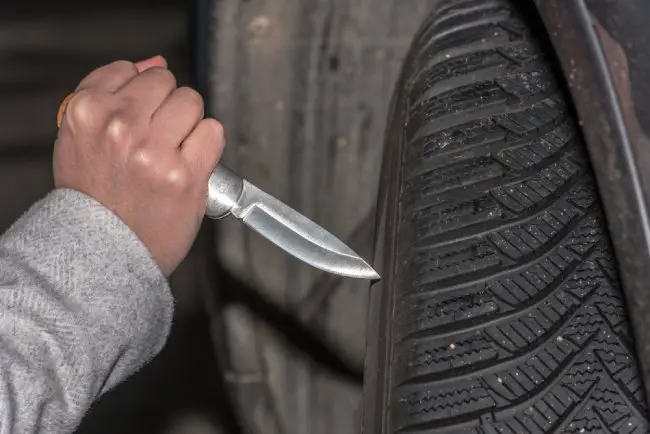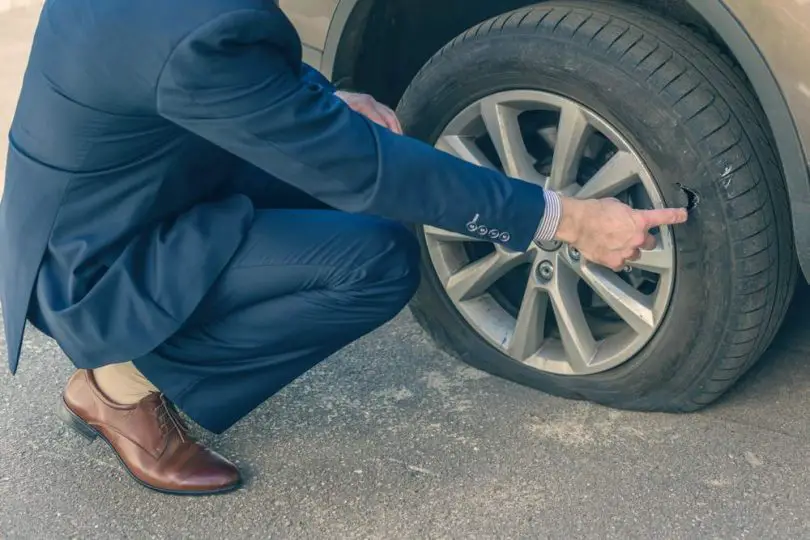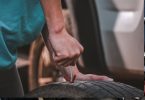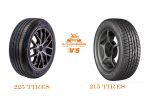How would you like to wake up one morning and find that all of your car tires had been slashed?
Well, here we are on the other side of the picture! Here we will show you how to do it the safest and most effective way.
Whether for revenge or urgency, you need to know how to go about the process so only the tire is slashed, not you!
Follow our guide and stay on the safe side.
Reasons for Slashing Tires

1. To settle a score
Whether you’re slashing a tire to prevent a blowout or to settle a score, there are some things you should know first.
It is an act of vandalism to slash the tires of a vehicle that you do not own without the owner’s consent, and in court it will be treated as criminal mischief, a misdemeanor, or a felony offense.
Depending on the worth of the slashed tire, the most severe punishments for this offense is 30 days to seven years behind bars.
2. Blowout prevention
Sidewall tire blowout causes approximately 2,000 accidents per year in the United States, according to the National Transportation Safety Board.
If your tire is extremely overinflated, and you need to prevent an explosion, tire slashing is in order.
Be prepared for it to be loud, and face away from the tire when the puncture happens to protect your eyes from injury.
3. To restrict movement
In other cases, the police sometimes slash people’s tires to prevent or restrict them from going anywhere.
This was demonstrated in the case of the May 2020 protests going on in Minneapolis, regarding the murder of George Floyd.
When questioned why large numbers of car tires had been slashed by the police, the spokesman for the Minnesota Department of Public Safety, Bruce Gordon, responded in a statement to NPR:
“State Patrol troopers strategically deflated tires to keep vehicles from being used in the attacks, and so we could tow the vehicles later for collection of evidence if necessary.”
Tools You Can Use to Slash Tires
Whatever the reason for the necessity to slash a car tire, you will need a sharp, pointed tool in order to do so, as the rubber used for making vehicle tires is very thick and strong.
- Serrated knife
- Awl
- Pricker
- Bodkin
- Nail
- Screwdriver
It is possible to use tools like a nail or a screwdriver, but you’ll have to put in more effort in that case, because they are not nearly as sharp. Remember that the rubber is very thick. So whatever tool you use, try to make the cut as deep as possible in order to create the desired effect.
You’ll want to go into the side of the tire, and not the outside where the tread is. This is because there are a series of metal wires intertwined just below the surface of the rubber tread to reinforce the tire and make it strong.
How to Slash Tires – 5 Easy & Safe Methods

1. Nail trap
For this method, you’ll need a roofing nail and a bottle cap.
First, puncture the top of the bottle cap with the roofing nail using a hammer, and pound it all the way through.
This way, you’ll have a way to stabilize the nail so that it stays pointed upright when you set it on the ground.
Then, simply leave the contraption wedged under the tire so that when the tire moves, the nail will puncture the tire, ensuring a slow leak that will let all of the air out of the tire after approximately 15 or 20 minutes.
The bottle cap will have broken off or disintegrated by that time.
2. Small puncture with a sharp knife
This one is pretty self explanatory, but there are a few things you should know before you attempt it.
You’ll want the knife that you use to have a sharp tip and be serrated, and be sure to go into the sidewall of the tire and not the tread to make for an easier and more effective puncture.
First, make several small radial cuts into the side of the tire, then make your deep cut at an angle into the sidewall.
Remember to face away from the tire when you do this in order to protect your face, neck, and eyes. If the tire is not attached to a car, put it between your legs while puncturing it in order to stabilize it, or, alternatively, you can kneel on it to prevent movement, slipping, and a possible accidental injury.
3. Removing tire parts
You may want to consider removing some parts of the tire instead of puncturing it outright. To do this, you can remove the spring-loaded valve from the valve stem.
This way, when the owner attempts to fill it with air from a filler hose, as soon as he or she removes it, all of the air will simply escape back out of the tire.
Alternatively, you can remove the needle in the valve stem and then cut the valve’s stem, remove the cover to it, and press on the needle-like core in order to slowly let the air out of the tire.
4. Horizontal slashes
To deflate a tire quickly, make several horizontal slashes into the side of the tire. This requires less force than just jabbing once at the tire, and makes for a faster deflation.
5. Slashing on one strike
This is the noisiest method, but slashing in one strike is sometimes a necessity, especially if you are looking to do the job quickly and then get away as fast as possible.
Keep in mind that you’ll need an extremely sharp object, and that serrated knives work better than non-serrated ones.
Again, face away from the tire when you are in the act of slashing it for safety reasons.
Bonus Tips
- Don’t limit yourself to only one tire—for the most damage to be caused, you might consider slashing multiple tires.
- Be aware of CCTV cameras, because they are everywhere these days, especially in parking lots of businesses.
- Pop tires without making noise—to make the least amount of noise, use an especially sharp tool, always go into the sidewall, and try to use less force and go slowly if you want the least amount of noise. A quick jab, especially with a blunted tool like a screwdriver, will make the most noise and also put you at the greatest risk of injury.
Avoid Getting Your Tires Slashed
- Drive responsibly: don’t drive carelessly, and discipline yourself. Think about what could damage your tires and purposefully avoid those things.
- Park in public places with a lot of people around: don’t park in dark, secluded areas. Instead, park your car where there are streetlights and people around so that somebody would notice an act of malice.
- Count on CCTVs in store parking lots and other highly populated areas: you can install cameras where you usually park, and also look up high on the poles in the parking lots of places you frequent, because there may be cameras already installed.
- If in public space, park in a secure location: make sure you park in an open, well-lit area.
- Guard dogs: probably one of the biggest deterrents to would-be slashers. Nobody wants to get bitten by a big dog.
How to Deflate Tire Without Slashing?
This involves removing parts of the tire to make it deflate slowly and it also prevents refilling with air.
There are valves in car tires whose job is to control air flow in and out of the tires.
Get long needle-nose pliers or a tire valve tool to remove the valve stem by twisting it.
Once removed, the air inside will come out of the tire.
The tire will deflate fully in a few minutes.
How to Repair a Slashed Tire?
- Using a jack, lift your car so that the entire tire is off the ground, placing the jack near the damaged tire.
- Use a lug nut wrench to remove the tire.
- If you can’t find the slash, sponge on soapy water to the tire, which will cause the slashed area to bubble, making it easier to identify. Be sure to wipe the soapy water over the entire tire, so that you can identify if there are more slashes to be found.
- Using a tire buffer, prepare the area for your vulcanized liquid and tire patch.
- Spread the vulcanized liquid over the slash and wait for it to dry completely.
- Fill up the tire with air using the air pressure stipulations that you will find on the side of the tire.
- When the tire is full of air, put the tire patch over the vulcanized liquid, making sure it is totally flat. Let the patch sit and settle for at least five minutes.
- Place the tire back on your car.
FAQs
1. How much force does it take to slash a tire?
Ans. When puncturing the sidewall of the tire, it takes surprisingly little force, especially if applying deep, sustained pressure with a very sharp, pointed object. If you were attempting to puncture the tread or did not have a sharp object, it would take a lot more force.
2. Does car insurance cover slashed tires?
Ans. Your car insurance will cover slashed tires with comprehensive coverage. No matter the number of tires damaged, your car insurance will cover it, depending on the plan that you have.
A comprehensive car insurance coverage covers damage to tires due to flood, theft, hail, and vandalism, so whether it was a person or a tree branch from a storm that punctured your tire, you’re covered.
There are also tire protection plans available from the actual tire dealer, which might be something to consider when purchasing your tires. Depending on how the tire was slashed you might also be able to use your collision damage to pay for your tires.
3. How to file a claim for slashed tires?
Ans. In order to file a claim for your slashed tires, contact your insurance company, and, in the event of vandalism, the police, right away. Provide as many details as you are able to, and get photographic evidence of the slashed tire, and note the time, date, and location of your vehicle when you found it with the damaged tire(s).
If you didn’t see the slashing, it’s okay to estimate the time. It’s important to file an accurate claim so that your provider covers the cost of the damage. Then, replace your tires. Common reasons why an insurance provider would not cover a claim is if the appraiser determines that you slashed the tires after getting a flat, you violated traffic laws or were driving unsafely when the damage happened, or your drove over tire spikes.
4. What does a slashed tire look like?
Ans. If you’re not sure if your tire got slashed or simply had a crack in the sidewall, examine the cut carefully. A slashed tire will have a clean, straight cut, and a crack will be jagged and look stretched.
5. How to Make Use of Slashed Tires
Ans: Simple DIY things can be made from slashed tires like garden chairs, dog beds, an indoor ottoman, and feeder pots.
6. What can pop a tire easily?
Ans: The things that contributes the most to pop a tire are: sharp objects, wear and tear, valve stem leakage, improper inflation, bad road condition, and heat.
7. Does slashing a tire make a loud noise?
Ans: Not always. Slashing a tire can produce a loud, attention-grabbing noise if the tire is not depressurized.
8. How bad of a crime is it to slash someone’s tires?
Ans: In court, if you don’t have any previous criminal record, you may get a fine, probation, and need pay for the slashed tire.










Leave a Comment